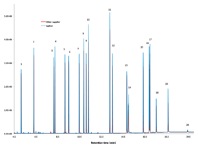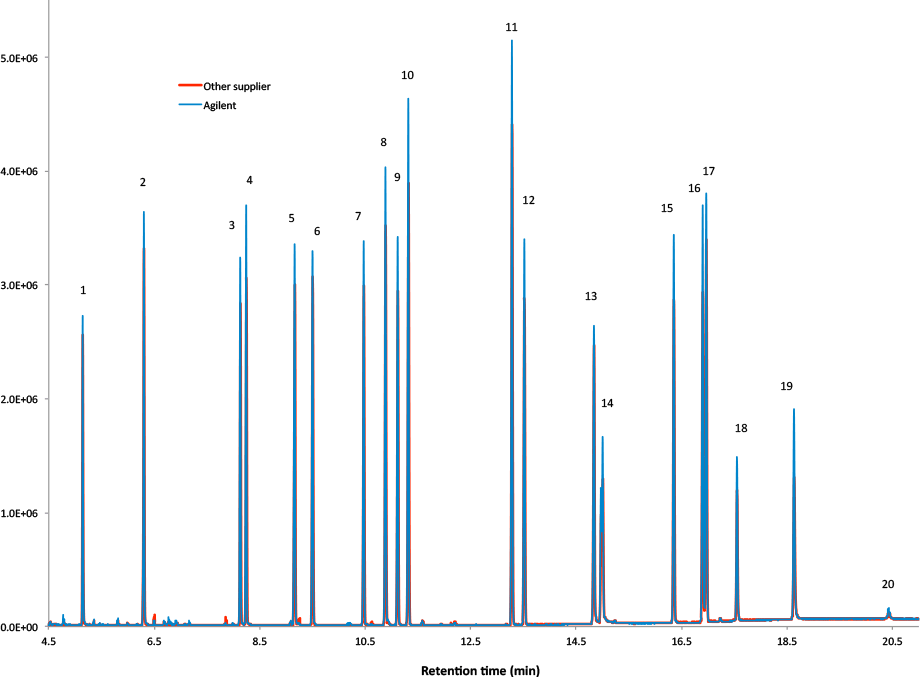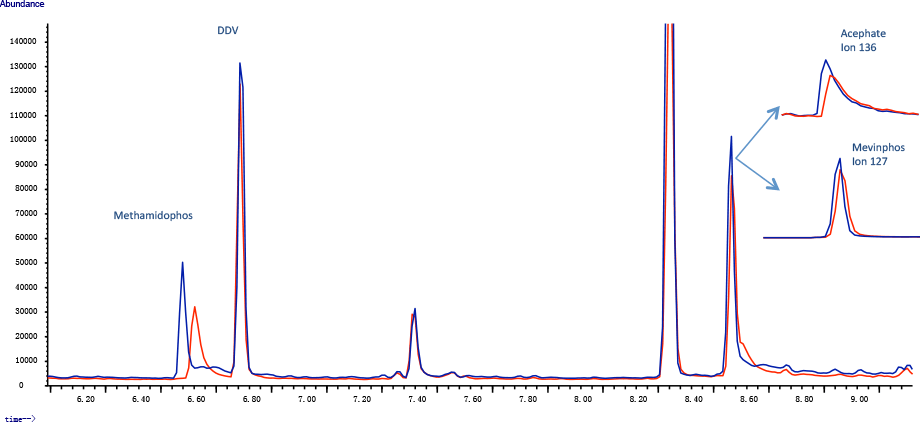Access Agilent eNewsletter August 2015
>> Update My Profile | Subscribe to Access Agilent | Article Directory

Fast, convenient pesticide analysis with
Agilent J&W Ultimate Plus tubing
By Yun Zou, Ngoc A. Dang, and Andy Zhai
Agilent GC Applications
Gas chromatography (GC) analysis of pesticides has been plagued for years with problems of dirty or complex matrices, and many of these pesticides break down due to activity inherent in the system.
Flow path inertness plays a critical role in accuracy, precision, durability, and consistency of pesticide analysis in complicated sample matrices. The susceptibility of highly sensitive compounds to active sites in the instrument flow path can result in poor peak shape, poor reproducibility, and significant loss of sensitivity. Every component of the flow path, including deactivated fused silica (FS) tubing, can contribute to overall system activity. This type of tubing is widely used as guard columns and restrictors for pesticide analysis.
 Enlarge
Enlarge
Figure 1. An overlay of total ion current chromatograms of a pesticide checkout mixture at 10 ng/component on-column when Agilent J&W Ultimate Plus and another supplier’s tubing was alternately used as the GC restrictor for the MS interface.
Ultimate Plus tubing delivers better inertness as a restrictor
Deactivated fused silica tubing is often used as a GC restrictor for mass spectrometry (MS) in the analysis of pesticides. Restrictor tubing delivers fast and convenient analysis because it lets analysts quickly change analytical columns without turning off the high vacuum of the MS.
To demonstrate, we evaluated the performance of Agilent J&W Ultimate Plus deactivated FS tubing by comparing it with tubing from another supplier. Figure 1 shows how Ultimate Plus tubing improved inertness performance. We found good peak shapes and significant improvement in responses of all target compounds.
The results suggest that Agilent J&W Ultimate Plus deactivated fused silica tubing used as restrictor plays a key role to delivering an inert flow path for fast, sensitive, and reproducible analysis of pesticides in food applications. You will find full details of this work in Agilent publication 5991-5404EN.
Agilent QuEChERS provides quick, easy, cost-effective sample prep
Due to complex matrices, multiresidue analysis of pesticides in fruits, vegetables, and other foods is always a challenge for sample preparation and detection. Agilent QuEChERS sample prep is applied widely because it is “Quick, Easy, Cheap, Effective, Rugged and Safe”. However, food extracts processed by QuEChERS are still complicated because they contain impurities, such as high-boiling compounds that can cause contamination of the analytical column.
Guard columns for pesticide analysis help prevent sample contamination
In applications for pesticides analysis, guard columns are widely used in GC and GC/MS to protect the analytical column from contamination. Guard columns can also extend the lifetime of capillary columns. The most common dimension of the guard column is 5 m x 0.25 mm. If surface area is proportional to the potential for active sites, the guard column has more than eight times more active sites than the liner. To minimize analyte degradation and peak tailing, the guard column should be highly inert.
 Enlarge
Enlarge
Figure 2. Endrin and DDT breakdown profile for Agilent J&W Ultimate Plus deactivated fused silica tubing and tubing from other suppliers.
We evaluated Agilent J&W Ultimate Plus deactivated FS tubing as a guard column, compared with tubing from other suppliers. Endrin and DDT breakdown is a useful probe to evaluate the inertness of a guard column. Figure 2 compares percentage endrin and DDT breakdowns over 70 injections. DDT breakdown was stable for all tubing, but after 50 injections, tubing from the other suppliers already exceeded the critical level of 15% endrin breakdown.
Agilent J&W Ultimate Plus deactivated fused silica tubing delivered superior inertness for the analysis of active compounds. Full details are freely available in Agilent publication 5991-5914EN.
Symmetrical peak shapes and decreased sample adsorption with Agilent
In another guard column comparison, a representative group of difficult pesticides, including organophosphates, organochlorines, carbamates, and pyrethroids, were spiked in tomato matrix blank samples. They were extracted with Agilent Bond Elut QuEChERS kits and analyzed on an Agilent J&W HP-5ms Ultra Inert column.
 Enlarge
Enlarge
Figure 3. Enlarged section of GC/MS chromatogram of problematic polar pesticides. Agilent Ultimate Plus deactivated FS tubing (blue), supplier R guard column (red).
The more polar pesticides can be problematic, often yielding broad peak shapes or excessive tailing that makes reliable quantitation at low levels difficult. Figure 3 is a GC/MS/SIM chromatogram of polar pesticides on different suppliers’ tubing. Compared to supplier R guard column, the high level of inertness of Agilent J&W Ultimate Plus deactivated FS tubing gives better peak shape and decreased sample adsorption, allowing lower detection limits.
As before, the surface inertness improvement of the Agilent J&W Ultimate Plus deactivated FS tubing delivered good symmetrical peak shapes and significant improvements in responses for critical active pesticides. Learn more by reading Application Note 5991-5974EN.
High-performance Agilent solutions for all your pesticide analysis applications
Agilent J&W Ultimate Plus deactivated FS tubing improves GC flow path performance when used as guard columns or restrictors for pesticide analysis in complicated matrix. The tubing is just one of many Agilent innovative products designed to improve performance and minimize downtime in your GC and GC/MS analyses. Take a moment to check out the whole family.
>> Update My Profile | Subscribe to Access Agilent | Article Directory
Figure 1.

Peak no. Pesticide Retention time (min)
- Dichlorvos 5.144
- Mevinphos 6.304
- Ethalfluralin 8.131
- Trifluralin 8.244
- Atrazine 9.157
- Lindane 9.501
- Chlorpyrifos methyl 10.47
- Heptachlor 10.884
- Malathion 11.113
- Chlorpyrifos 11.317
- p,p'-DDE 13.281
- Dieldrin 13.516
- Hexazinone 14.833
- Propargite (isomer A) 14.972
- Propargite (isomer B) 15.003
- Leptophos 16.351
- Fenarimol 16.897
- Mirex 16.966
- Coumaphos 17.548
- Etofenprox 18.633
- Deltamethrin 20.428
An overlay of total ion current chromatograms of a pesticide checkout mixture at 10 ng/component on-column when Agilent J&W Ultimate Plus and another supplier’s tubing was alternately used as the GC restrictor for the MS interface.

